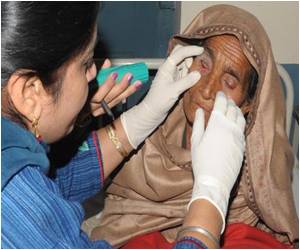More than 50% of eye-donations in India go waste, as eye banks receive Rs.2,000 from the government for every pair of eyes donated.

However, data from the Ministry is somewhat alarming. It shows that as many as 51,354 eyes were donated in 2013-14, but only 22,384 were used for transplantation. The figures for utilization have remained more or less the same over the past few years with only 50% of the donated eyes getting utilized.
Medindia, in an exclusive, investigated the reason behind this low utilization and had some surprising revelations. Our investigations revealed two main reasons for the poor quality of the corneas were as follows:
a. Lack of awareness and understanding by relatives on how to preserve the eyes after death of their loved ones
b. Incentive payment of Rs.2,000 by the government for each donation to the eye bank working against the system
The family members who wish to donate the eyes of their relatives should understand that the eyes that get dry and swollen after death, deteriorate very fast and cannot be used for transplantation. To keep them from drying, one needs to keep the eyes moist by using a wet cotton swab. Other precautions that need to be taken include switching off the fan over the body, propping the head under a pillow (to reduce swelling) and switching on air conditioner in the room, if available.
Gulati, head of the non-profit health organization that focused on eliminating corneal blindness in India, also said that government should encourage retrievals of only transplantable tissues such as corneas. “In the next five-year plan, government should include a new scheme to increase eye donation. Eye banks should be paid only for transplantable eyes. Or else, the government should ensure a great amount for transplantable eyes and a small amount for other retrievals. This will encourage eye banks to collect more transplantable eyes,” he added. He noted that the initiative of the government to create awareness on eye donation is still not successful. “There is only a narrow increase of 1 or 2% in the number of voluntary eye donators in the country every year. This shows that government awareness programs are not up to the mark and failing to attract more donors,” he said.
Lalitha, who had earlier worked with the Eye Bank Association of India, said that half of donated eye are actually not going waste. “The eye those can’t be used for optical purpose is actually used for research, ” she said.
Dr. S. Tony Fernandes, a Padmashree awardee for his contributions to eye care, said that lack of coordination among eye banks also leads to eye wastage. “Tamil Nadu leads the country in cadaver organ donation. Unlike their cadaver organ donation program, there is no free flow of information between eye banks to facilitate eye donations. Better co-ordination among eye banks is important and they must be open to information sharing,” he said.
He said that Eye Bank Association of India (EBAI) should work as a centre for all India activities of coordination and networking for procurement and distribution of eyes.
“A national level registry should be maintained for eye donation and eye transplantation. The association should also take necessary steps to make people aware of eye donation. As of now, the situation is miserable and people are less aware of activities of eye banks and what are they used for,” he added.
Eyes donated in hospitals have a better quality. The success with cadaver organ donation has resulted in improved eye donation in the hospitals. In fact, the number of eye donations are much more than solid organ donation, thanks to this programme. An example of this success is the Rajiv Gandhi General Hospital in Chennai. There were hardly any donations taking place before the cadaver programme started. In the last three years, there have been around 100 corneal donations.
To improve the quality of corneas should be the focus of Government of India and Medindia’s recommendations to the Government are as follows:
1. Create more awareness on not only eye donation but also the do’s and don’ts of corneal donation
2. Provide incentives at two levels to eye banks depending on the quality of the corneas and its utilization.
3. More corneal donation and procurement should be encouraged in hospitals.
4. Better coordination between eye banks and corneal transplanting centers.
Source-Medindia







